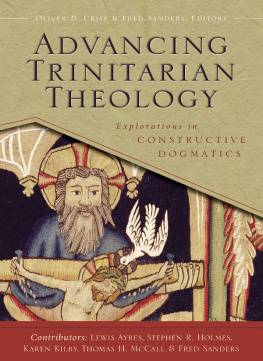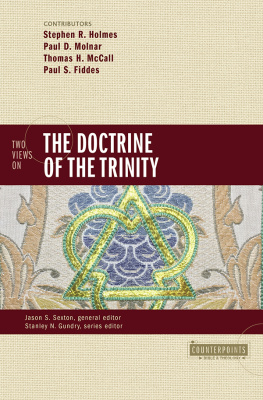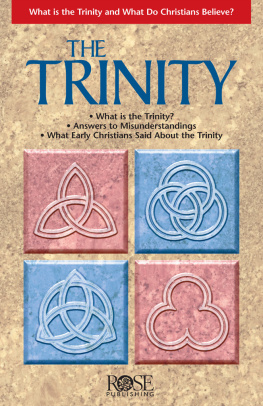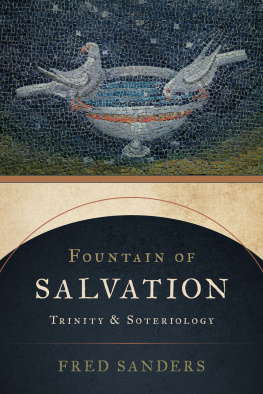THOMISTIC RESSOURCEMENT SERIES
Volume 1
SERIES EDITORS
Matthew Levering, University of Dayton
Thomas Joseph White, O.P., Dominican House of Studies
EDITORIAL BOARD
Serge-Thomas Bonino, O.P., Institut Catholique de Toulouse
Lawrence Dewan, O.P., Dominican College of Ottawa
Gilles Emery, O.P., University of Fribourg
Reinhard Htter, Duke University
Bruce Marshall, Southern Methodist University
Emanuel Perrier, O.P., Dominican Studium, Toulouse
Richard Schenk, O.P., Dominican School of Philosophy and Theology
Kevin White, The Catholic University of America
The Trinity
An Introduction to Catholic Doctrine on the Triune God
GILLES EMERY, O.P.
Translated by Matthew Levering
The Catholic University of America Press
Washington, D.C.
Originally published as La Trinit:
Introduction Thologique la doctrine catholique sur Dieu Trinit
(Paris: Les ditions du Cerf, 2009).
Copyright 2011
The Catholic University of America Press
All rights reserved
The paper used in this publication meets the minimum requirements of American National Standards for Information SciencePermanence of Paper for Printed Library Materials,
ANSI Z39.481984.
Library of Congress Cataloging-in-Publication Data
Emery, Gilles
[Trinit. English]
The trinity : an introduction to Catholic doctrine on the triune God / Gilles Emery ; translated by Matthew Levering.
p. cm (Thomistic ressourcement series; v. 1)
Includes bibliographical references and index.
ISBN 978-0-8132-1864-9 (pbk. : alk. paper) 1. Trinity. 2. Catholic ChurchDoctrines. 3. TrinityHistory of Doctrines. I. Title.
BT111.3.E4514 2011
231'.044dc22
2010053807
ISBN-13: 978-0-8132-1903-5 (electronic)
Contents
Translator's Foreword
As an introduction to the Trinity, this book presents the origins and development of a Trinitarian Christian culture. Gilles Emery provides the reader with the background not only to appreciate this culture, but also to enter into it. At every stage (biblical, patristic, and systematic) he pays particular attention to doxology and prayer, showing how the historical and contemplative dimensions of Trinitarian doctrine are inseparable. The mark of vibrant Trinitarian culture consists in its ability to appropriate the witness of the Scriptures to the triune God by means of the interweaving of doxological praise, creedal confession, and intellectual precision. Not surprisingly, the early Church developed a vibrant Trinitarian culture.
With particular attention to the Niceno-Constantinopolitan Creed, Emery skillfully presents the patristic doctrine of the Trinity and the lineaments of analogous discourse about God. His discussion of the personal relations of the Father, Son, and Holy Spirit draws especially upon Thomas Aquinas. In Emery's hands, Thomas Aquinas's work of intellectual precision is shown to be a spiritual exercise that fosters the Church's liturgical union with God the Trinity. In order to appreciate the Trinity's creative and salvific acts, the Church must be able to speak about the eternal and transcendent Trinity in its inner life.
Rather than being merely a historical or a systematic introduction, Emery's book is a model of what it means to have a fully cultivatedTrinitarian sensibilitybiblically, liturgically, dogmatically. In clear and accessible prose, Emery moves from the witness of Scripture and faith, to doctrinal formulation of the Trinity in itself, to the creative and saving act of the Trinity. Each chapter can be read on its own as an introduction to its subject. Even so, students would do best to read the book as a whole, starting from the biblical witness to the Trinitarian economy of salvation and returning to this economy in the final chapter, enriched by the fruits of Trinitarian culture. Read in this way, the book not only teaches about the doctrine of the Trinity, but also cultivates Trinitarian wisdom in its readers.
This book first appeared in French. The present English version contains some new elements. After the publication of the French version, the author revised and updated the text, and these valuable emendations have been integrated into this English edition. My thanks to Gilles Emery and Dominic Legge, O.P., for carefully reading and correcting the translation.
Matthew Levering
Abbreviations and References
| CSEL | Corpus Scriptorum Ecclesiasticorum Latinorum, Vienna |
| CCSL | Corpus Christianorum, Series Latina, Turnhout |
| PG | Patrologiae Cursus, Series Graeca, Migne, Paris |
| PL | Patrologiae Cursus, Series Latina, Migne, Paris |
| SC | Sources Chrtiennes, Paris |
| a. | article |
| ch. | chapter |
| dist. | distinction |
| q. | question |
| qla | little question within an article (quaestiuncula) |
Abbreviations of the biblical books are those of the Revised Standard Version, Catholic edition. Biblical citations are drawn from the Revised Standard Version, Catholic edition (1966; San Francisco: Ignatius Press, 1995). For the Greek text of the New Testament: The Greek New Testament, 4th rev. ed., ed. Barbara Aland, Kurt Aland, Johannes Karavidopoulos, Carlo M. Martini, and Bruce M. Metzger (Stuttgart: Deutsche Bibelgesellschaft, 1993).
Citations of the Ecumenical Councils are drawn from Decrees of the Ecumenical Councils, vol. 1: Nicaea I to Lateran V, ed. Norman P. Tanner (Washington, D.C.: Georgetown University Press, 1990); and vol. 2: Trent to Vatican II, ed. Norman P. Tanner (Washington, D.C.: Georgetown University Press, 1990).
Citations of the Catechism of the Catholic Church are drawn from Catechism of the Catholic Church, 2nd ed. (Vatican City: Libreria Editrice Vaticana, 1997).
For other magisterial texts, when I cite Enchiridion symbolorum, my citations are drawn from: Heinrich Denzinger, Enchiridion symbolorum, definitionum et declarationum de rebus fidei et morum, 37th ed, ed. Peter Hnermann (Freiburg im Breisgau: Herder, 1991).
Citations of the works of St. Thomas Aquinas refer to Latin editions whose bibliographic details can be found in Jean-Pierre Torrell, Saint Thomas Aquinas, vol. 1: The Person and His Work, rev. ed., trans. Robert Royal (Washington, D.C.: The Catholic University of America Press, 2005), 33059 and 42438. The translations are at times made with the help of available English translations (cited in Jean-Pierre Torrell's work). The references follow the paragraph numbers of the Marietti edition (Turin/Rome).
Introduction
The mystery of the Holy Trinity is the substance of the New Testament, Pope Leo XIII recalled in his encyclical on the Holy Spirit, Divinum illud munus (1897). The Trinity is not one topic of reflection among others, but rather it constitutes the heart of Christian faith. To affirm that the Trinity is the substance of the New Testament is to recognize that the Trinity is found at the center of the Gospel, that it is the essential reality of the Gospel, and that it is the very object of faith, hope, and charity. Indeed, the Holy Trinity is the greatest of all mysteries, since it is the fountain and origin of them all. The Catechism of the Catholic Church likewise affirms:
The mystery of the Most Holy Trinity is the central mystery of Christian faith and life. It is the mystery of God in himself. It is therefore the source of all the other mysteries of faith, the light that enlightens them. It is the most fundamental and essential teaching in the hierarchy of the truths of faith. The whole history of salvation is identical with the history of the way and the means by which the one true God, Father, Son and Holy Spirit, reveals himself to men and reconciles and unites with himself those who turn away from sin.







